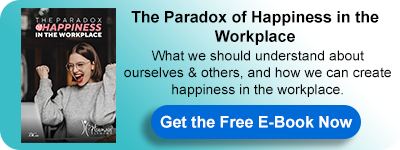Positive Emotions At Work
"It is your responsibility to make sure that positive emotions constitute the dominating influence of your mind" – Napoleon Hill
Dave, a hardworking young man, has been well known around the office for his passion, vitality, and enthusiasm. Walking around Dave's office, you would find sticky notes and wooden plaques hung around the wall. Most of them carried positive emotions such as interest, hope, love, and much more.
On top of Dave's desk lies a mystical glass jar, covered in stars, suns, and moons. When a colleague asked Dave once about all the paper slips within, he replied, "it's my happy moments' jar. Whenever I feel serenity, awe, interest, or any positive emotion, I scribble it on a slip of paper and put it into my jar. When I feel down, I know where I should head; to my happy jar."
When Martin Seligman referred to Positive Emotions, he did not mean only happiness. What he meant was a broader array of emotions. A wide variety of positive emotions would, in the end, lead to satisfaction and happiness. To discuss this, we cannot ignore the works of Barbara Fredrickson, author of "Broaden and Build Theory".
Through her well-studied theory, Broaden and Build, Barbara describes that our experience differs when we face positive emotions vs. negative ones. The impact is on our entire body. For example, negative emotions such as anger or fear constrict eye vision to help us get ready for a fight or flight response. Whereas positive emotions broaden and widen vision, help us absorb details, scenery, thus aiding with creativity when solving problems.
What Barbara discussed are ten emotions that are a subset of positive emotions. Particularly:

What the Broaden and Build theory shows is that positive emotions widen the momentary thought-action repertoire. Simply put: feelings spark thoughts, and thoughts respectively spark action. When we experience negative feelings, they might spark adverse action and negatively reflect our physical aspect: for example, constricting eye vision, thus narrowing down visible options. Yet, when emotions are positive, contemplated action might be positive, even physically.
Positive emotions, therefore, build personal resources, ranging from physical and intellectual to social and psychological ones. Hence, positive emotions lead to positive experiences that create a depth in personality, experiences, and skills used later on during hardships for coping and surviving.
For example:
- Joy sparks an urge to be playful
- Gratitude kindles prosocial behavior
- Serenity helps us savor and integrate
- Interest pushes us towards learning and exploring
- Hope ignites our need to plan for a better future
- Pride makes us dream big
- Amusement fires our need to show joy and laughter
- Inspiration pulls us towards our own higher grounds and purpose
- Awe helps us calm and accommodating
- While love enlightens us with all the above with mutual care
Now, that we understand the theory, we know how Dave unintentionally built his bright personality. Why he oozed enthusiasm and passion.
But how then can we build similar Daves in the workplace? Where do we go from here?
On an individual level, what Dave is doing, is such a powerful tool that helps him understand himself more. Therefore, it all simply starts with Self-Awareness:
- Raise your self-awareness, aim to understand yourself
- Pay attention to your emotions, what triggers you
- Track your emotions in a diary or notebook. How your emotions affect specific actions, write down what makes you happy and what does not
- Know your strengths, utilize them. Observe how this impacts your emotions, therefore, your actions
- Explore life-like three years old. Go back to being curious. Explore different skills. Explore doing things differently.
On an organizational level:
- Help employees explore. Organizations need to promote creativity coupled with risk-taking.
- Promote growth, allow errors and mistakes through creating a system of learning
1 Barbara L. Fredrickson and Michael A. Cohn, Chapter 48, Positive Emotions, Pep Lab, Accessed 20 Jul 2021, https://peplab.web.unc.edu/wp-content/uploads/sites/18901/2018/11/fredricksoncohn2008.pdf
2Accessed 20 July 2021, https://thehumanelement.bconglobal.com/what-is-the-human-element/principles
3 Accessed 20 July 2021, https://lifo.bconglobal.com/what-is-lifo/introduction
For more about this topic, download our latest book " The Paradox of Happiness in the Workplace " for FREE:
